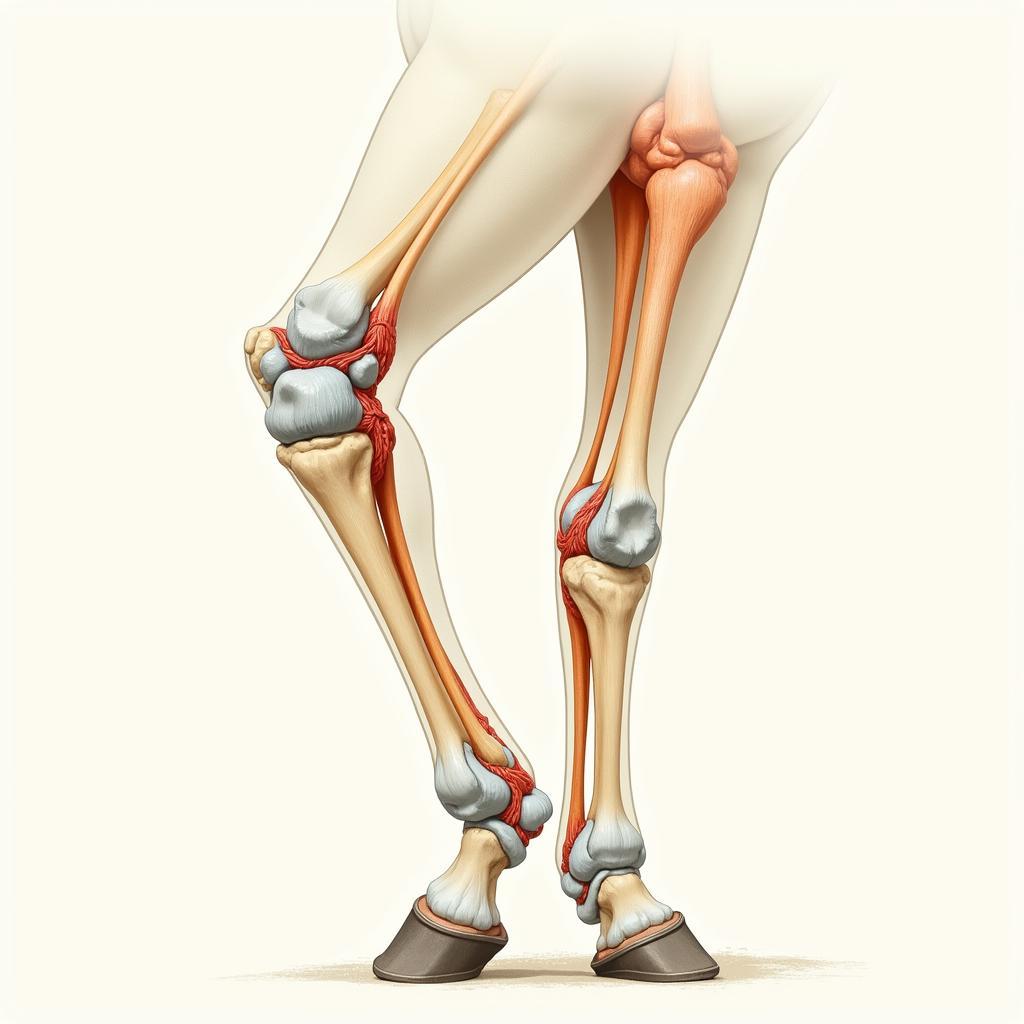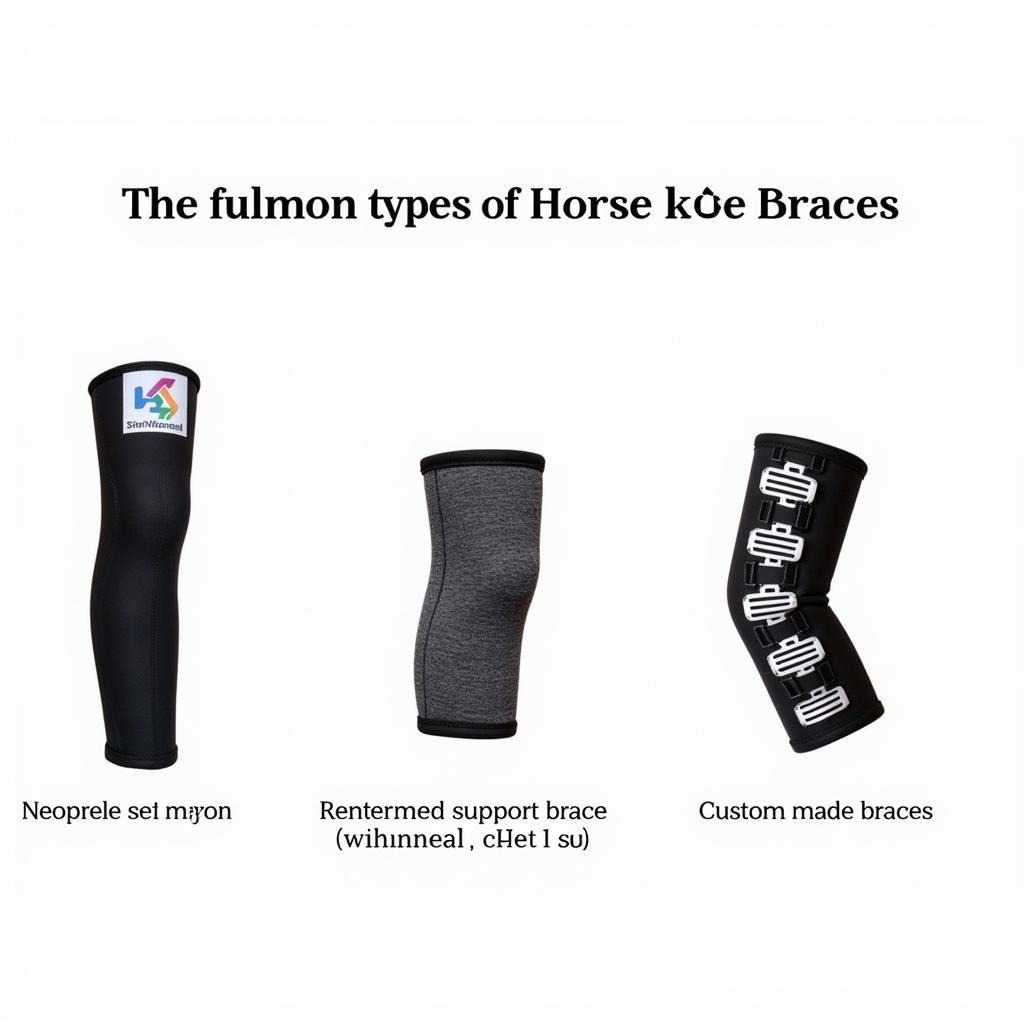A Knee Brace For Horses is a valuable tool designed to provide support, stability, and pain relief to injured or compromised equine knees. Whether your equine partner is recovering from surgery, managing arthritis, or experiencing instability, a knee brace can play a crucial role in their rehabilitation and overall well-being.
Understanding Equine Knee Problems and the Role of Braces
Horses, with their impressive size and athleticism, often place significant stress on their legs, particularly the knees. The equine knee, analogous to the human wrist, is a complex joint composed of bones, ligaments, tendons, and cartilage, all working in unison to facilitate movement. However, this intricate joint is susceptible to a range of problems, including:
- Ligament injuries: Ligaments, the tough bands of tissue connecting bones, are prone to sprains or tears, particularly during high-impact activities or sudden movements.
- Tendonitis: Tendons, which attach muscles to bones, can become inflamed or strained, leading to pain and lameness.
- Arthritis: This degenerative condition affects the cartilage within the joint, causing pain, stiffness, and reduced range of motion.
- Hyperextension: The equine knee, unlike the human knee, is more stable in flexion than extension. Hyperextension occurs when the joint bends backward beyond its normal range, potentially damaging ligaments and other structures.
 Horse Knee Anatomy
Horse Knee Anatomy
A knee brace for horses can address these issues by:
- Providing support: The brace acts as an external support system, stabilizing the joint and reducing stress on injured ligaments or tendons.
- Restricting movement: By limiting range of motion, the brace prevents potentially harmful movements that could exacerbate an injury or delay healing.
- Reducing inflammation: Compression provided by the brace can help to minimize swelling and inflammation, promoting a more comfortable healing environment.
- Improving proprioception: Proprioception refers to the body’s awareness of its position in space. The brace provides sensory feedback, enhancing the horse’s awareness of its knee joint and promoting stability.
Types of Knee Braces for Horses
Equine knee braces are available in various designs, each tailored to address specific needs:
Neoprene Support Braces
These braces, often used for mild to moderate support, are constructed from neoprene, a synthetic rubber material. Neoprene offers flexibility, compression, and warmth, making it suitable for managing inflammation, providing mild support, and offering therapeutic warmth.
Reinforced Support Braces
For more significant injuries or instability, reinforced support braces incorporate additional features like:
- Metal or plastic splints: These rigid elements provide enhanced stability and restrict movement in specific directions.
- Adjustable straps: Straps allow for a customized fit, ensuring optimal support and comfort.
Custom-Made Braces
In some cases, veterinarians may recommend custom-made braces, particularly for horses with unique anatomical features or complex injuries. Custom braces are crafted from molds taken of the horse’s leg, ensuring a precise and comfortable fit.
 Different Horse Knee Braces
Different Horse Knee Braces
Choosing the Right Knee Brace for Your Horse
Selecting the most appropriate knee brace for your equine companion requires careful consideration and veterinary guidance. Factors to consider include:
- Severity and type of injury: A mild sprain might only require a neoprene support brace, while a more severe ligament injury might necessitate a reinforced brace with splints.
- Intended use: Braces designed for rehabilitation may differ from those intended for performance or preventative purposes.
- Fit and comfort: A properly fitted brace should be snug but not restrictive, allowing for comfortable movement and preventing chafing or sores.
- Durability and maintenance: Consider the brace’s construction, materials, and ease of cleaning and maintenance.
Benefits of Using a Knee Brace for Horses
When used appropriately and under veterinary supervision, knee braces offer numerous benefits for horses:
- Reduced pain and inflammation: The brace’s supportive and compressive properties help to alleviate pain and minimize inflammation, promoting a more comfortable recovery.
- Enhanced stability and support: By stabilizing the joint, the brace reduces stress on injured tissues, facilitating healing and preventing further injury.
- Improved mobility and range of motion: As healing progresses, the brace can be gradually adjusted to allow for increased range of motion, promoting joint flexibility and strength.
- Faster recovery times: The supportive environment created by the brace can expedite the healing process, allowing horses to return to activity sooner.
- Prevention of future injuries: In some cases, knee braces are used prophylactically, particularly in performance horses, to provide support and reduce the risk of injury during strenuous activities.
When to Consult a Veterinarian
If you suspect your horse may benefit from a knee brace, it’s essential to consult with a qualified equine veterinarian. The veterinarian will:
- Conduct a thorough examination: This may include a physical exam, lameness evaluation, and diagnostic imaging (such as X-rays or ultrasound) to assess the extent of the injury or condition.
- Recommend the most appropriate brace: Based on the diagnosis and the horse’s individual needs, the veterinarian will recommend the most suitable type of brace.
- Ensure proper fit and application: The veterinarian will demonstrate how to correctly fit and apply the brace, ensuring optimal support and comfort for your horse.
- Develop a rehabilitation plan: In many cases, a knee brace is used in conjunction with other therapies, such as controlled exercise, medications, or physical therapy.
Tips for Using a Knee Brace Effectively
- Follow veterinary instructions: Adhere to your veterinarian’s guidelines regarding brace wear, adjustment, and any accompanying therapies.
- Introduce the brace gradually: Allow your horse to acclimate to the brace gradually, starting with short periods of wear and increasing duration over time.
- Monitor for any signs of discomfort: Regularly inspect your horse’s leg for any signs of rubbing, chafing, or swelling. Contact your veterinarian if you notice any issues.
- Maintain the brace properly: Clean the brace regularly according to the manufacturer’s instructions to ensure hygiene and longevity.
Knee Braces for Horses: Supporting Recovery and Enhancing Well-being
A knee brace can be a valuable tool in the management and recovery of various equine knee conditions. By providing support, stability, and pain relief, these braces contribute significantly to a horse’s comfort and well-being, enabling them to return to activity and enjoy an active lifestyle. Remember, a thorough veterinary assessment is crucial to determine the need for a brace and to ensure its appropriate selection, fit, and use.
Frequently Asked Questions About Knee Braces for Horses
1. How long does a horse need to wear a knee brace?
The duration of brace wear varies depending on the nature and severity of the condition. Some horses may only require a brace for a few weeks, while others may need it for several months or longer.
2. Can horses exercise with a knee brace?
Yes, controlled exercise is often part of the rehabilitation process for horses wearing knee braces. Your veterinarian will advise on appropriate exercises and activity levels.
3. Are knee braces only used for injuries?
No, knee braces can also be used prophylactically to support the joint and potentially reduce the risk of injury, particularly in performance horses engaged in strenuous activities.
4. How do I know if the brace fits my horse correctly?
A properly fitted brace should be snug but not restrictive. It should not cause any rubbing, chafing, or discomfort. Your veterinarian will demonstrate the correct fit and application.
5. What should I do if my horse experiences discomfort while wearing the brace?
If your horse shows signs of discomfort, remove the brace and contact your veterinarian. They may need to adjust the fit, modify the wear schedule, or address any underlying issues.
Need Help Choosing the Right Knee Brace for Your Horse?
We understand that selecting the appropriate knee brace for your equine partner can feel overwhelming. If you have any questions or need guidance, please don’t hesitate to reach out. Contact us at Phone Number: 0772127271, Email: [email protected], or visit us at QGM2+WX2, Vị Trung, Vị Thuỷ, Hậu Giang, Việt Nam. Our dedicated team of equine experts is available 24/7 to provide personalized support and assist you in making the best decision for your horse’s well-being.
Explore our website for more informative articles on various horse care topics, including fly mask horse, uv horse mask, horse proxy extension, hat for horse, and fly mask on horse. We are committed to providing you with valuable resources to support your horse’s health and happiness.